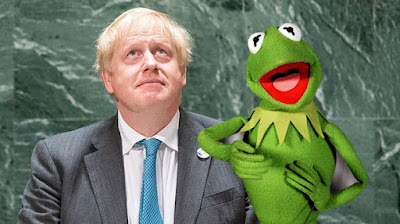Overview: Energy prices pulled back late yesterday, but it offered little reprieve to the bond market where the 10-year benchmark yields in the US, UK, Sweden, and Switzerland reached new three-month highs. November WTI traded to almost .70 before reversing lower and leaving a potentially bearish shooting star candlestick in its wake. The US S&P 500 and NASDAQ gapped lower and did not recover, setting the stage for today’s drop in Asia. All the major markets sold off but Hong Kong. However, the sell-off stopped in Europe, where the Dow Jones Stoxx 600 is snapping a three-day slide. US futures indices are also trading higher. The gaps created by yesterday’s sharply lower opening may be key to the near-term outlook. They are found roughly between
Topics:
Marc Chandler considers the following as important: 4.) Marc to Market, 4) FX Trends, Brexit, China, COVID, Evergrande, Featured, GBP, Japan, newsletter, U.K., USD
This could be interesting, too:
Nachrichten Ticker - www.finanzen.ch writes Die Performance der Kryptowährungen in KW 9: Das hat sich bei Bitcoin, Ether & Co. getan
Nachrichten Ticker - www.finanzen.ch writes Wer verbirgt sich hinter der Ethereum-Technologie?
Martin Hartmann writes Eine Analyse nach den Lehren von Milton Friedman
Marc Chandler writes March 2025 Monthly
Overview: Energy prices pulled back late yesterday, but it offered little reprieve to the bond market where the 10-year benchmark yields in the US, UK, Sweden, and Switzerland reached new three-month highs. November WTI traded to almost $76.70 before reversing lower and leaving a potentially bearish shooting star candlestick in its wake. The US S&P 500 and NASDAQ gapped lower and did not recover, setting the stage for today’s drop in Asia. All the major markets sold off but Hong Kong. However, the sell-off stopped in Europe, where the Dow Jones Stoxx 600 is snapping a three-day slide. US futures indices are also trading higher. The gaps created by yesterday’s sharply lower opening may be key to the near-term outlook. They are found roughly between 4419-4436 in the S&P 500 and 14817-14865 in the Nasdaq. The US 10-year Treasury yield is consolidating and slipped below 1.50% in European turnover. European yields are softer, led by a 4-5 bp decline in Italy and Greece’s 10-year benchmarks. The dollar is mostly firmer, though the yen, Swiss franc, and the Canadian and Australian dollars resist the pressure and post small gains near midday in Europe. Most of the liquid and freely accessible emerging market currencies are higher, and the JP Morgan Emerging Market Currency Index is trying to end a three-day downdraft. Gold slipped below $1730 yesterday and is now probing resistance a little above $1740. The 4.1 mln barrel crude build estimated by API saw November WTI slip to $73.75 today after trading a little above $76.65 yesterday. It is recovering to approach $75 in Europe. Industrial metals are mixed. The CRB Index has a six-day rally in tow coming into today.
Asia Pacific
Japan’s Kishida edged out Kono to become the leader of the LDP. Next week (October 4), the Diet will confirm him as the next Prime Minister. Like the other LDP candidates, he favors a large fiscal stimulus effort, which is likely to be presented ahead of the national election, seen in November. We have identified another component of the LDP consensus, and that is a harder line toward China. Seeming unrelated to the LDP politics, Japan’s Government Pension Investment Fund, citing settlement, liquidity, and stability concerns, announced it would not invest in sovereign Chinese bonds. Separately, in the face of a sharp drop in infections and a vaccination rate that has now surpassed the US, outgoing Prime Minister Suga announced the lifting of the state of emergency as of tomorrow.
Evergrande reportedly has sold a stake in a banking unit to a local Chinese government for CNY10 bln (~$1.5 bln), but the proceeds are not expected to be used to service bondholders but to settle debts with the bank. Reports suggest that at least 10 banks told investors in recent weeks that they have sufficient collateral for loans. Evergrande shares rose 15% today in Hong Kong, leaving it down around 80% for the year. The dollar bonds due next year fell and appeared to close slightly below 25 cents, a record-low close. Separately, China will report its PMI and the Caixin manufacturing PMI tomorrow before the week-long holiday begins on Friday.
The US dollar set a marginal new high for the year against the yen (~JPY111.65) before reversing. It found bids near JPY111.20 in early European turnover. The market does not appear done with the upside, and provided it holds above JPY111, where an option for about $360 mln expires today, the greenback still looks poised to test the JPY112.00 area. That said, dollar finished yesterday above its upper Bollinger Band for the third consecutive session. It is found near JPY111.30 today. The Australian dollar’s trough appeared to forge last week, around $0.7220 was tested yesterday and today, and it held. The upside has been limited to almost $0.7265. Resistance in the $0.7315-$0.7320 area needs to be overcome to signal anything notable. The dollar gapped higher against the Chinese yuan and reached CNY6.4760 before slipping to CNY6.4635. Yesterday’s high was slightly below CNY6.4620. The PBOC continued to set the dollar’s reference rate tightly to expectations (CNY6.4662 vs. CNY6.4664). The central bank continued to inject liquidity into the banking system, and it has reached about CNY750 bln in the nine days of operations. Lastly, Chinese regulators want Chinese banks to provide faster fx quotes and tighter spreads.
Europe
Over the past month, UK rates have risen more than the US. Egged on by the Bank of England, the market boosted the chances of a hike before year-end. Yet, sterling is unloved. It is the weakest major currency this month and yesterday’s drop of more than 1.1% was the largest in over a year. It has eased further to test $1.35 today. While tempting to attribute sterling’s weakness to the dollar’s strength, the pound has been sold to its lowest level in a couple of months against the euro. The euro closed above GBP0.8600 for the first time since July 20 and has edged nearer to the 200-day moving average (~GBP0.8650), which it has not traded above since mid-January. The market seems to be worried about a policy mistake. Monetary and fiscal policy is set to tighten, and the higher energy prices, in this context, are like another consumption tax. Part of the energy shortage in the UK is also idiosyncratic and related to structural conditions of the labor market on this side of Brexit. Meanwhile, it antagonizing Europe by granting only 12 of 47 applications for fishing licenses, and the debate over the Northern Ireland protocols appears to be intensifying.
Today’s Trade and Technology Council meeting in Pittsburgh between the US and EU is unlikely to resolve the steel and aluminum tariffs that the Trump administration imposed on national security grounds that remain in place eight months into Biden’s term. The EU postponed its plan to double its retaliatory tariffs to give the US administration plenty of opportunities to resolve it. The US has proposed a combination of a tariff and a quota, which the EU rejects as violating WTO rules. It wants a similar deal the US worked out with Canada and Mexico, which seems to be more about monitoring flow than protectionist tariffs. Moreover, the US steel industry appears to have overcome the pre-pandemic challenges.
The eurozone reports the August unemployment rate tomorrow, but the week’s data highlight is the September CPI estimate on Friday. Ahead of it, Spain reported that its EU harmonized measure jumped more than expected, rising 1.1% in September to lift the year-over-year rate to 4.0% from 3.3%. The median forecast in Bloomberg’s survey was for a 3.6% rate. German states report tomorrow, but Brandenburg said today that its CPI slipped by 0.1% to bring the year-over-year rate to 4.8% from 5.0%. As a whole, the country is expected to report that the EU harmonized measure rose by 0.2% for a 4.0% year-over-year pace (3.4% in August).
The euro was sold to a new low for the year today, slightly ahead of $1.1655. Since recording the low, the single currency has not been able to resurface above $1.1680, and there is a billion-euro expiring option that says it will not get above $1.17. Note that there is an even larger option there that expires tomorrow (~1.77 bln euros). A break of $1.1650 could spur a move toward $1.1600, last seen on the night of the US election last November. Sterling has been sold to $1.35, a new low since January. The year’s low was set on January 11 near $1.3450, which is the next target. Below there, the $1.3385 area corresponds to the (61.8%) retracement of sterling’s rally since the low early last November (~$1.2855).
America
Many observers still seem confused about the US macabre fiscal policy. There are two distinct issues. The first is spending authorization. The federal government is not authorized to spend funds after September 30. This could lead to a government shutdown on Friday unless a stopgap bill is authorized. As some have proposed, a short-term extension to early December will mean a new fight before the end of the year. The debt ceiling is about paying for the past spending that was authorized. This is the dine-and-dash analogy. The failure to resolve by lifting or abolishing the debt ceiling leads to the risk of default. While the government and markets have some experience dealing with short government shutdowns (though not during a pandemic), default would be unprecedented. The root of the problem is not money but politics. The Democrats want a bipartisan agreement to lift the debt ceiling, and the Republicans are not inclined to go along. Under Bush, then-Senator Biden and current Majority Leader Schumer voted against raising the debt ceiling, insisting that the Republicans who had a majority in both chambers did it on their own. The seats have changed, but this is what passes for politics in the US. The Senate Democrats have abandoned their attempt to link the stopgap spending bill from the debt ceiling, but the odds of success look narrow.
The looming debt ceiling may have encouraged some banks to avoid the T-bills that expire in mid-October and push more funds into the reverse repo facility, which saw record use yesterday (~$1.365 trillion). To stay under the debt ceiling, Treasury has allowed bills to roll off, exacerbating the squeeze that lifted the four-week bill yield to five basis points, more than double the yield of the three-month bill. The US sold 2, 5, and 7-year notes this week. The results have been solid, even if not spectacular. The US reports pending home sales today, which tend not to move the market even in the best of times. Canada, Mexico, and Brazil also have light economic calendars today. Four Fed officials speak today, including Chair Powell at the ECB forum that also features Bailey, Kuroda, and Lagarde.
The US dollar posted an outside up day against the Canadian dollar yesterday, trading on both sides of Monday’s range and settling above its highs. It is consolidating in a narrow range near yesterday’s highs. We like it lower and initial support is seen near CAD1.2660, with a break allowing a return to the CAD1.2600 area. The expiring option at CAD1.2620 for $1.4 bln looks too far away to be impactful, but an option that expires Friday at CAD1.2600 for $1.8 bln could come into play. Amid the equity drama yesterday, the greenback set a new high for the month, a little shy of MXN20.40. The weakness of the peso reinforces ideas that Banxico will hike rates again tomorrow. The dollar is consolidating and has been down to MXN20.2835 so far. A close below MXN20.20 would help stabilize the peso’s technical tone. Note that the dollar spiked higher against the Brazilian real too and briefly poked above BRL5.45. Last month’s high was closer to BRL5.4740. The short-term momentum indicators warn it is stretched. Initial support may be seen in the BRL5.38-BRL5.40 band.
Disclaimer
Tags: #GBP,#USD,Brexit,China,COVID,Evergrande,Featured,Japan,newsletter,U.K.









